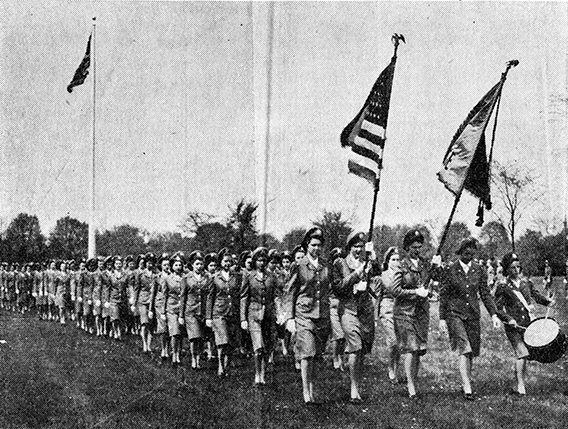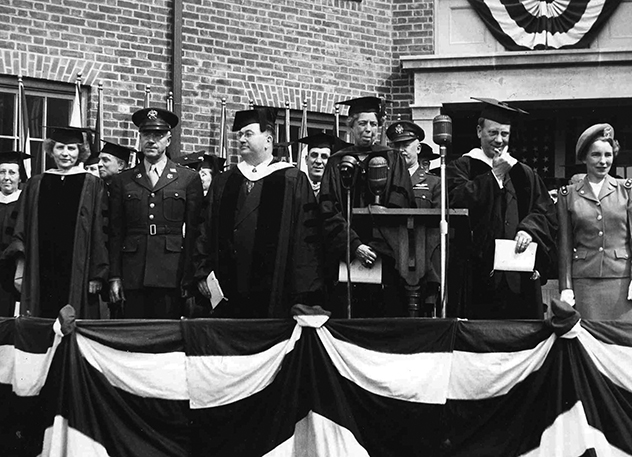With World War II raging in February of 1943, Adelphi opened its nursing school with an enrollment of just under 30 women. By October of that year, 187 women were enrolled.
Today, Alumnae and Harvey halls are the bustling academic homes of the College of Nursing and Public Health and the Ruth S. Ammon School of Education. Just over 60 years ago, though, they were built for a very different purpose: as dormitories for the women enrolled in the Central Collegiate School of Nursing—a unit of the U.S. Cadet Nurse Corps and the predecessor to Adelphi’s College of Nursing and Public Health.
With World War II raging, the country faced a dearth of nurses to treat wounded soldiers at home and abroad. Hence, through the Bolton Act, Congress funded training for nurses who joined the U.S. Cadet Nurse Corps at schools such as Adelphi. In February of 1943, Adelphi opened its nursing school with an enrollment of just under 30 women. By October of that year, 187 women were enrolled.
The need for proper housing was immediately apparent. First-year nursing cadets—as they were known—either commuted to campus or lived in the Adelphi gym—the building that is now Woodruff Hall. Former dean Ruth S. Harley ’24, ’50 (Hon.) recalled in a 1979 interview that the 34 first-year cadets living in the gym referred to their quarters variously as Hopper-Haven, Bed-Side Manor and Grand Central.
Following the Depression, Adelphi was in debt, and paying for new student housing required creative financing. In her book, A History of Adelphi University (Boston: Pearson, 2014), Adelphi Professor of English Jennifer Fleischner, Ph.D., explains the scheme: Adelphi sold a plot of its mortgaged land to the Alumnae Association who then deeded it to the federal government for construction. Through the Lanham Act, administered by the Federal Works Administration, Adelphi secured two successive grants of $170,000 and $155,000 to build two residence halls to house 200 women. McKim, Mead & White—the renowned architectural firm that had designed Adelphi’s first three Garden City buildings (today’s Levermore, Blodgett and Woodruff halls)—designed the L-shaped dormitories with 50 rooms apiece as well as some administrative offices, recreation rooms and service rooms. East Hall, which was later renamed Alumnae Hall in honor of the Alumni Association, was completed first. West Hall, later dubbed Harvey Hall in honor of Anna E. Harvey, dean of Adelphi from 1922 to 1935, followed soon after.
On May 6, 1944, First Lady Eleanor Roosevelt joined College leaders and other dignitaries, including the U.S. Surgeon General, to dedicate the buildings. She said prophetically, “I am very glad that in a time of war we can dedicate a building which, while it is dedicated to war service now, will continue to be of service to this college and this community after the war is over.”
Dr. Betty L. Forest ’47, ’10 (Hon.), who was among the 4,000 audience members that day, recalled that “We wore our cadet nurse uniforms, and we learned to march!” She and her friends, who had been living in the gym, were “just tickled” to have the new quarters. Once the dorms were open, groups of young women could be seen carrying entire dresser drawers full of clothing across campus to their new rooms.
In a 2004 interview for A History of the Adelphi University School of Nursing—by Ellen (Krawiecki) Florentine ’86, M.S. ’04—Ann (Callahan) Dick ’47 recalled, “I missed Eleanor Roosevelt’s visit, but I heard so much about it, that I felt like I was there.” Dick moved into the dorms in September 1944 and said, “A week later, on the twelfth, we had a hurricane and the new roof leaked like a sieve.”
Dick vividly remembered the housemother, Mrs. Davis, a survivor of the battles of Bataan and Corregidor, who strictly enforced the evening curfew. “She was a tough old, chain-smoking nurse, but we loved her anyway.”
The 1956 Oracle yearbook is the last one in which students are listed as living in either Alumnae or Harvey Hall. The 1958 Oracle reported that Adelphi’s Institute of Health, Education and Welfare had been established in Alumnae Hall. (As its name implies, the institute offered graduate programs in a range of health-related areas, including nursing, social work and psychology.)
In 2015, with the opening of the Nexus Building and Welcome Center—the new home of the College of Nursing and Public Health—Alumnae Hall will take on a new life as a faculty office building.
This piece appeared in AU VU, Fall 2014 issue.


